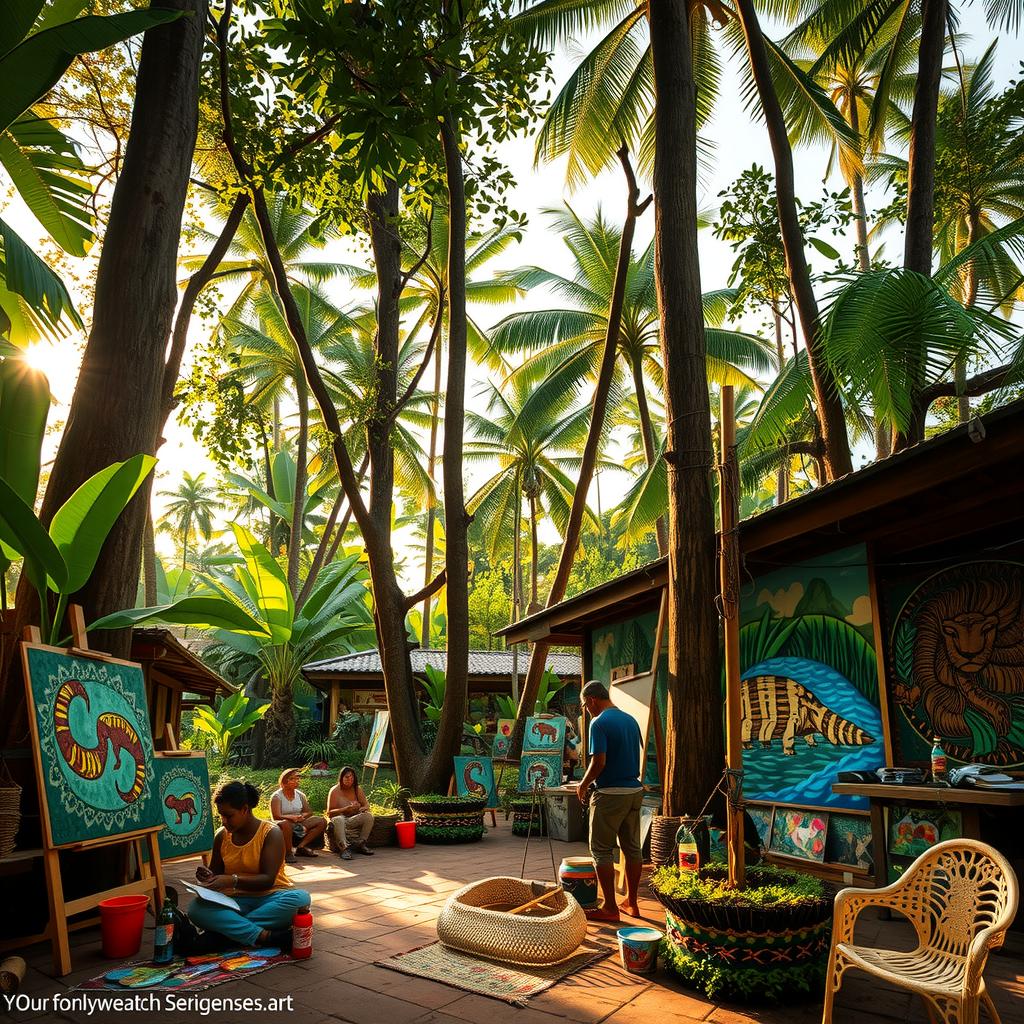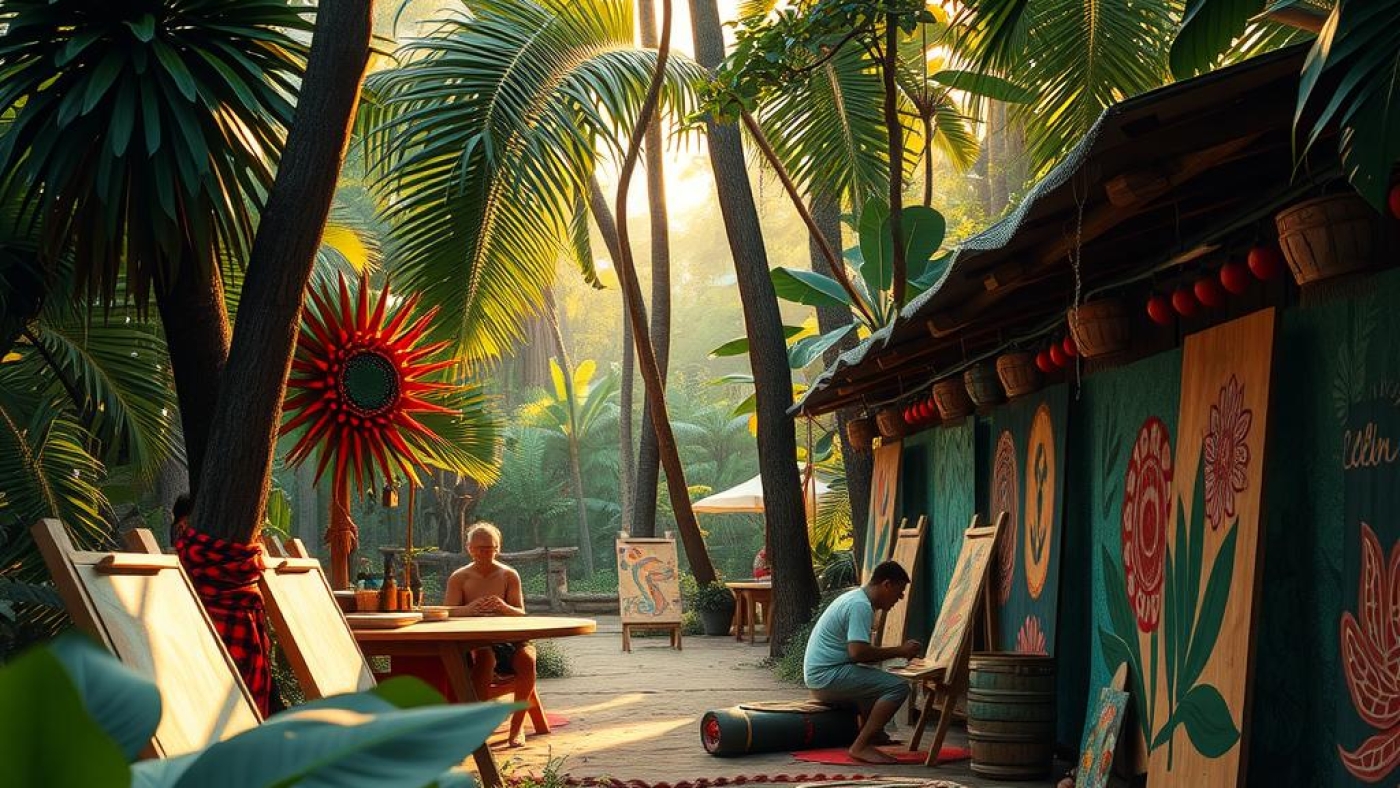In an age where mass tourism often threatens the delicate balance of local cultures and ecosystems, there lies a transformative opportunity within the indigenous art communities of the Amazon. These vibrant groups not only preserve their rich cultural heritage but also offer pathways to sustainable tourism that can benefit both visitors and local populations alike. As travelers seek authentic experiences that leave minimal impact on the environment, they are increasingly drawn to eco-tourism initiatives that celebrate indigenous traditions while promoting environmental sustainability. The allure of experiencing breathtaking landscapes paired with meaningful interactions with local artisans presents a compelling case for why these communities stand at the forefront of responsible travel.
The challenge, however, is ensuring that such involvement supports rather than exploits these sustainable communities. Many regions in the Amazon have faced pressures from outside influences, leading to concerns about resource depletion and cultural erosion. Yet through community engagement initiatives focused on preserving traditional crafts and arts, these indigenous art communities create economic opportunities while fostering appreciation for their unique way of life. Visitors who engage with local artisans gain insights into ancient techniques passed down through generations, learning firsthand how art serves as both expression and preservation.
Moreover, by prioritizing tourism practices rooted in respect for nature and culture—such as responsible wildlife tours or workshops led by skilled craftsmen—travelers can contribute positively to both conservation efforts and community livelihoods. This symbiotic relationship not only helps protect fragile environments but also empowers indigenous people by providing them with platforms to share their stories and artistry globally.
As we delve deeper into this topic throughout this article, readers will discover how embracing Amazon tourism centered around indigenous art paves new avenues for exploration while honoring essential values like respect for nature and recognition of cultural identity. It invites us all to rethink our approach to travel—not merely as consumers seeking adventure but as conscious participants in a global tapestry woven together by diverse cultures ready to be celebrated in harmony with our planet’s future.

Key Points:
-
Promoting Indigenous Art Communities: A Cultural Renaissance
The vibrant tapestry of indigenous art communities in the Amazon serves as a testament to rich histories and cultural significance. These communities are not only vital for preserving their unique heritage but also offer travelers an authentic glimpse into traditional craftsmanship. Through workshops led by skilled local artisans, tourists can engage deeply with the stories interwoven in every piece of art, fostering both appreciation and respect for these ancient cultures. -
Sustainable Practices through Eco-Tourism: A Win-Win Approach
As global interest in Amazon tourism surges, embracing eco-tourism initiatives becomes essential for ensuring that tourism benefits indigenous populations while protecting the environment. By prioritizing sustainable practices, visitors can support local artisans economically and socially. This engagement helps create sustainable communities where cultural heritage thrives alongside environmental stewardship, ultimately allowing tourists to contribute positively to both people and planet. -
Fostering Community Engagement: The Heart of Authentic Experiences
Genuine community engagement is key when exploring indigenous art communities within the Amazon rainforest. Tourists are encouraged to participate actively in eco-friendly practices that align with local values and traditions. Such interactions not only empower indigenous groups but also cultivate awareness regarding environmental sustainability efforts being implemented throughout the region. By building connections between travelers and these artistic communities, a thriving ecosystem emerges—one where culture and nature coexist harmoniously.

The Essence of Indigenous Art in the Amazon
Tracing the Roots of Cultural Expression
Indigenous art communities in the Amazon embody a profound connection to their cultural heritage, reflecting centuries-old traditions that are intricately tied to the land and its resources. These communities utilize various forms of artistic expression, including weaving, pottery, painting, and sculpture, often depicting stories from their ancestral past or significant events within their environment. The vibrant colors and intricate designs serve not only as a form of aesthetic pleasure but also as vehicles for storytelling and preserving history. As many indigenous artists engage with natural materials sourced sustainably from their surroundings—such as clay from riverbanks or fibers from local plants—they reinforce an ethos of environmental sustainability that underscores their relationship with nature. In this sense, each piece created is not merely art; it embodies a holistic view where culture intersects with ecology. Indigenous art thus stands as both an embodiment of identity and a call for awareness regarding ecological preservation.
Community Engagement Through Artistic Practice
Bridging Generations via Art
The role of local artisans in these indigenous art communities goes beyond mere creation; they act as custodians of knowledge and tradition passed down through generations. Workshops often serve as communal spaces where younger members learn ancient techniques while infusing contemporary themes into traditional practices. This dynamic exchange fosters community engagement essential for sustaining cultural identities amidst modern challenges such as globalization and tourism pressures on the Amazon ecosystem. Furthermore, by promoting eco-tourism initiatives centered around these artistic expressions—such as guided tours showcasing artisans at work or cultural festivals celebrating indigenous craftsmanship—the broader community benefits economically while tourists gain insights into authentic ways of life unfamiliar to them. Such interactions deepen mutual respect between visitors and indigenous peoples while enhancing appreciation for diverse worldviews reflected through Amazon tourism.
The Role of Environmental Sustainability
Harmonizing Culture with Nature
In addressing challenges posed by climate change and deforestation, indigenous art communities have emerged at the forefront advocating for environmental sustainability through creative means. Many artists incorporate themes related to conservation into their works—not only raising awareness about endangered species native to the Amazon but also illustrating how traditional practices can coexist harmoniously within modern frameworks aimed at protecting biodiversity. Projects focused on sustainable harvesting methods enable artisans to continue utilizing natural resources without depleting them completely—a vital aspect given ongoing threats from industrial exploitation across these lands.The symbiotic relationship between culture and environment becomes evident here: artistry serves both practical purposes (in producing goods) alongside emotional ones (connecting people spiritually). Thus emerges an urgent narrative woven throughout pieces crafted by local hands—a testimony underscoring resilience against external pressures threatening authenticity rooted firmly in place-based knowledge systems.
Preserving Heritage Through Contemporary Channels
Innovation Meets Tradition
As global interest grows towards cultural heritage, many indigenous artists capitalize on digital platforms to share narratives surrounding their unique identities found exclusively within remote corners like those dotted across Amazonia’s lush landscapes.This shift opens avenues previously inaccessible due primarily technological advancements leading increased visibility amid wider audiences hungry meaningful content.Initiatives focusing online sales bolster economic independence among creators who might otherwise rely heavily tourism fluxes vulnerable unpredictable circumstances brought forth pandemics conflicts alike.Additionally encouraging collaborations established between emerging talents paired seasoned veterans results innovative aesthetics blending historical motifs fresh perspectives captivating viewers seeking more than just decorative items rather tangible connections histories enriching lives.Such endeavors foster deeper understanding acknowledge complexities underpinning experiences shaped centuries ago still resonating profoundly today thanks unwavering commitment dedicated individuals striving honor legacy through ever-evolving mediums encapsulating essence rich tapestry woven together countless voices echoing timeless truths reminding us importance cherishing diversity ingrained society’s fabric overall landscape humanity itself transcending borders barriers time space alike enriching journey explore possibilities await when embracing full spectrum human creativity unfurling infinite potential exists forever entwined Earth beneath feet shared dreamers storytellers everywhere yearning connect hearts minds souls endlessly intertwining paths crossed along way discovering beauty lies within differences uniting us all ultimately igniting sparks inspiration lighting future brighter tomorrow awaits adventurers willing venture forth open hearts open minds exploring wonders awaiting discovery nurtured lovingly long since forgotten shadows illuminated anew.
The Essence of Eco-Tourism
Supporting Local Artisans through Responsible Travel
Eco-tourism has emerged as a vital force in promoting environmental sustainability while enhancing the socio-economic fabric of local communities. This approach encourages travelers to engage thoughtfully with their surroundings, particularly in regions rich in cultural heritage like the Amazon. By prioritizing responsible travel practices, tourists can directly support local artisans, fostering a sustainable economy that respects both nature and culture. Engaging with indigenous art communities allows visitors to appreciate unique crafts and traditions while ensuring that their spending contributes positively to the livelihoods of those who create them. For instance, purchasing handmade goods not only supports individual artists but also helps preserve age-old techniques and stories intrinsic to these cultures. Moreover, when travelers participate in workshops led by skilled artisans, they gain firsthand insight into traditional methods—transforming mere observation into meaningful engagement.
Environmental Stewardship through Community Engagement
Bridging Tourism and Sustainability
As eco-tourism continues to grow globally, it becomes increasingly essential for travelers to recognize their role as stewards of the environment. When tourists choose destinations that emphasize sustainable practices, such as conservation-focused tours or community-led initiatives, they contribute significantly to preserving natural habitats alongside supporting local economies. In this context, ethical tourism emphasizes collaboration with indigenous populations who have lived harmoniously within these ecosystems for generations. For example, engaging with sustainable communities often reveals opportunities for visitors to learn about traditional farming or fishing techniques that promote biodiversity while providing sustenance for families reliant on these resources. Furthermore, eco-tourists are encouraged not only to admire but also actively partake in restoration projects—like reforestation efforts—that benefit both local wildlife and human inhabitants alike.
Celebrating Cultural Heritage Through Artistry
A Pathway Towards Mutual Respect
The intersection of cultural heritage and eco-tourism offers a unique opportunity for mutual respect between visitors and host communities. Tourists drawn by the allure of authentic experiences frequently find themselves enriched by interactions with indigenous art forms deeply rooted within local traditions. This appreciation fosters an understanding that transcends transactional relationships; rather than merely consuming culture as outsiders do at typical attractions, responsible travelers become advocates for preservation efforts championed by local artisans themselves. By valuing authenticity over commercialized souvenirs—and opting instead for hand-crafted pieces created from sustainably sourced materials—travelers can help sustain artistic legacies threatened by globalization’s encroachment on cultural expressions.
The Future of Responsible Travel Practices
Sustaining Ecosystems While Empowering Communities
Looking ahead at the future landscape shaped by eco-tourism reflects an increasing awareness amongst consumers regarding ethical travel choices impacting global ecosystems profoundly yet subtly intertwined with societal wellbeing across diverse locales worldwide—including those found amidst lush greenery characteristic of areas like Amazonia itself! Travelers now possess greater power than ever before—to either uplift or undermine vulnerable environments depending on how responsibly they navigate tourist hotspots frequented predominantly due solely upon convenience factor alone! Thus arises importance surrounding integration between environmental stewardship initiatives aimed towards conserving fragile ecosystems AND empowering marginalized voices represented through talented hands crafting beautiful representations reflecting deep-rooted histories embedded within specific regions visited during excursions abroad! Ultimately though—it is imperative all parties involved prioritize dialogue fostered throughout collaborative partnerships encouraging holistic development benefiting all stakeholders equally whilst nurturing vibrant artistry continuing thrive amid changing worlds around us constantly evolving daily basis!
Empowering Local Artisans: The Heartbeat of Sustainable Tourism
Fostering Economic Opportunities through Community Engagement
In the context of growing tourism, community engagement emerges as a vital element for empowering local artisans and enhancing economic opportunities. As travelers increasingly seek authentic experiences, the role of indigenous art communities becomes paramount. These communities not only represent rich cultural heritage but also serve as stewards of traditional crafts that are often overshadowed by mass-produced souvenirs. Genuine engagement with these artisans fosters a symbiotic relationship between tourists and locals, where visitors gain insight into unique artistic expressions while contributing to local economies. For instance, workshops led by artisans in regions like the Amazon allow tourists to immerse themselves in crafting techniques passed down through generations, thus preserving cultural narratives while generating income for families reliant on their craft for sustenance. This model champions sustainable communities, ensuring that profits remain within local hands and directly support environmental sustainability initiatives.
Preserving Cultural Heritage Amidst Commercialization
Balancing Tradition and Modernity in Tourism Growth
As tourism expands rapidly across various destinations, there is an urgent need to balance the commercial aspects with efforts aimed at preserving cultural heritage. In many instances, indigenous art forms face threats from commercialization that risks diluting their authenticity. However, when tourism strategies prioritize partnerships with local artisans—such as collaborations that highlight traditional practices—these crafts can flourish rather than fade away amidst globalization pressures. By prioritizing eco-tourism initiatives that showcase genuine craftsmanship over generic tourist traps selling mass-marketed items, both travelers and host communities nurture an appreciation for indigenous art. Engaging visitors in storytelling sessions about these traditions not only enhances their experience but reinforces respect towards the creators behind each piece of artwork or handmade item they cherish.
Bridging Gaps Through Educational Initiatives
Knowledge Sharing as a Tool for Empowerment
Educational programs play a crucial role in bridging gaps between tourists’ understanding and local artisans’ skills within sustainable communities. When organized effectively—be it through workshops or interactive exhibits—the sharing of knowledge helps cultivate mutual respect among participants. These engagements provide invaluable platforms where tourists can learn about sustainable practices tied to artisan work while discovering how their purchases influence economic resilience within these vulnerable groups. Moreover, this educational aspect promotes awareness around responsible consumerism; encouraging buyers to consider the impact of their choices on both people and planet resonates deeply with today’s socially conscious travelers seeking meaningful interactions during trips to diverse destinations such as those found throughout Latin America’s rich tapestry woven from vibrant indigenous cultures—a testament evident within every crafted piece they encounter.
Supporting Infrastructure Development Through Collaboration
Building Networks That Strengthen Local Economies
To ensure long-term sustainability amidst burgeoning tourism growth necessitates strategic collaboration amongst various stakeholders including government entities, non-profits focused on community development alongside grassroots organizations representing local artisans. Creating infrastructure supportive enough allows these skilled individuals more access to markets wherein they can sell goods without fear exploitation typically encountered when intermediaries dominate sales channels; thus instilling fairness into transactions which benefits all sides involved economically speaking whilst attracting discerning consumers who value eco-tourism principles aligned with ethical purchasing behaviors reflective toward supporting marginalized peoples’ livelihoods too! Collaborative frameworks could include pop-up markets showcasing regional talent or even digital platforms promoting artisan stories globally thereby expanding reach beyond mere geographical confines—all reinforcing interconnectivity cherished so dearly among thriving artistic hubs dotted across landscapes steeped deep-rooted histories waiting patiently unveil beauty encapsulated beautifully through creativity nurtured lovingly beneath guiding hands skilled artistry inspired endlessly reflected upon surfaces adorned delicately celebrating ancestral legacies richly cherished forevermore!
Cultivating Lasting Relationships Built on Authentic Exchanges
The Future of Eco-Tourism Lies Within Artisan Collaborations
The future trajectory defined by eco-tourism hinges significantly upon cultivating lasting relationships built upon authentic exchanges between global citizens eager explore new horizons paired closely together alongside dedicated practitioners committed nurturing traditions merits preservation against evolving societal tides relentlessly reshaping cultural landscapes encountered throughout journeys taken far away home soil shared experiences forged connections inevitably result weaving intricate tapestries intertwining lives enriched evermore deeply understood solely via genuine dialogue established rooted firmly hearts minds alike! Ensuring inclusivity remains priority means recognizing contributions made tirelessly everyday artists striving uphold values inherent respecting diversity integral sustaining vibrant ecosystems flourishing harmoniously coexisting amid nature untouched juxtaposed man-made marvels – ultimately shaping holistic perspectives leading toward collective aspirations fostering environments breed prosperity compassionally foster ingenuity boundlessly inspiring endless possibilities awaiting discovery beckoning forth adventurous spirits yearning embark enlightening quests filled wondrous insights gleaned exploring paths less traveled unveiling treasures hidden plain sight revealing magnificence resting comfortably embraced unity through shared exploration transcending boundaries bringing people together amplifying voices once silenced now echoing joyfully resonating strength courage triumphantly celebrated artistically represented forming bonds enrich our world colorful kaleidoscope woven intricately celebrating humanity’s dimensional existence unfolding beautifully lifetime adventures await just outside comfort zones daring embrace challenges uncover secrets lie dormant longing reveal richness life offers those willing take leap faith forge connections redefine futures ripe opportunities awaiting fulfillment driven perseverance passion
Frequently Asked Questions:
Q: What defines the role of indigenous art communities in promoting sustainable tourism in the Amazon?
A: The role of indigenous art communities is pivotal as they embody cultural heritage and traditional craftsmanship that tell the stories of their ancestors. By engaging these communities through eco-tourism initiatives, tourists can contribute to economic opportunities while fostering an appreciation for environmental sustainability. This synergy enhances both cultural preservation and responsible travel practices.
Q: How do local artisans benefit from visitors interested in Amazon tourism?
A: Local artisans gain significant benefits from visitors drawn to Amazon tourism by showcasing their craftsmanship and sharing knowledge about their traditions. Such interactions not only empower these artists economically but also help keep their cultural heritage alive. Tourists participating in workshops with local artisans create a bridge between cultures, promoting mutual respect and understanding.
Q: In what ways can travelers support environmental sustainability while visiting indigenous art communities?
A: Travelers can support environmental sustainability by prioritizing eco-friendly practices during their visits to indigenous art communities. This includes choosing responsible tour operators who emphasize community engagement, respecting local customs, and minimizing ecological footprints. By doing so, tourists play an essential role in ensuring that both culture and nature thrive harmoniously within this biodiverse region.
